Birds of Hawaii: The Endemic Avifauna
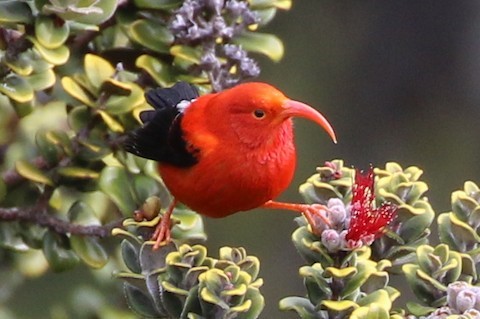
I’iwi at Haleakala National Park on Maui. © Henggang Cui
Hawaii’s avifauna has suffered enormous losses to extinction, but still retains 31 endemic bird species, plus a few distinctive subspecies (including one that is possibly a species). Seventeen of the surviving endemics are “Hawaiian honeycreepers”—which are a diverse branch of the finch family that evolved bills of widely varying shapes and uses. Apart from the honeycreepers, the other fourteen surviving endemics are a goose, two ducks, two tubenoses, a hawk, a coot, three monarchs, a crow, two thrushes, and a reed-warbler.
Hawaiian Endemics
Hawaiian Goose / Hawaiian Duck / Laysan Duck / “Hawaiian Storm-Petrel” / Hawaiian Petrel / Newell’s Shearwater / Hawaiian Hawk / “Hawaiian Gallinule” / Hawaiian Coot / “Hawaiian Stilt” / “Hawaiian Noddy” / “Hawaiian Short-eared Owl” / Kauai Elepaio / Oahu Elepaio / Hawaii Elepaio / Hawaiian Crow / Oma’o / Puaiohi / Millerbird / Akikiki / Maui Alauahio / Palila / Laysan Finch / Nihoa Finch / Akohekohe / Apapane / I’iwi / Maui Parrotbill / Akiapola’au / Anianiau / Kauai Amakihi / Oahu Amakihi / Common Amakihi / Hawaii Creeper / Akeke’e / Hawaii Akepa
Five of these are effectively confined to areas that are off-limits to the general public, so it’s best not to count on seeing a Laysan Duck, Hawaiian Crow, Millerbird, Laysan Finch, or Nihoa Finch. Four more—the Puaiohi, Akikiki, Akohekohe, and Maui Parrotbill—are very scarce and can sometimes be found through a combination of advance planning and tremendous luck. The other 22 can be found by visiting a few key locations on Kauai, Oahu, Maui, and the Big Island.
Birds of Hawaii: pages 1-4
In addition to the 31 Hawaiian endemics that are universally regarded as species, five more are “distinct forms,” some of which might eventually be reclassified as separate species. One in particular, the “Hawaiian Noddy”, differs visibly from its closest relatives to a degree that seems sufficient for full species status. The others—a storm-petrel, a gallinule, a stilt, and an owl—are less distinctive and seem more likely to remain classified as subspecies.
Hawaii’s three endemic waterfowl species have all come close to extinction, and all are still listed as endangered, though their prospects have improved substantially in recent decades.

Hawaiian Goose. (Pua Akala Tract, Hakalau Forest National Wildlife Refuge, Big Island, Hawaii; November 28, 2015.) © Alan Van Norman
After teetering on the brink of extinction in the mid-1900s, the Nene (NAY-NAY) became a conservation success story. Populations have recovered from a low in 1950 of about 20 to 30 in the wild plus 13 in captivity to a wild population of approximately 2,500 in the 2010s. About 60% are on Kauai, where it can be found at Koke’e State Park and most wetland sites, including Hanalei and Kilauea Point National Wildlife Refuges, Kawai’ele Waterbird Sanctuary, Kauai Lagoons, the golf courses around Poipu, and Hanapepe. Locally common on Maui in Haleakala National Park and seasonally at Kanaha and Kealia Ponds, and on the Big Island, where Hawaii Volcanoes National Park, Wailoa River State Park, and the golf courses at Pu’u Anahulu and Waikoloa are consistent sites. Also reintroduced to Molokai and appears to be returning naturally to Oahu.
A pale-brown goose with a black face, crown, and nape, deep-buffy cheeks, and a pale-buffy neck with furrowed black streaks. Found in open habitats that span from alpine meadows down to coastal wetlands and golf courses.

Laysan Duck. (Sand Island, Midway Atoll National Wildlife Refuge, Hawaii; January 1, 2020.) © Breck Tyler
Endemic to the Northwest Chain: Laysan Island and Midway and Kure Atolls. Formerly widespread in Hawaii, but Polynesian settlement likely extirpated it from the main islands. From 1911 to 1936, the global population was 20 or fewer, all on Laysan, and is thought to have reached the extreme low of a single female with eggs in 1930. By 1961, it had rebounded to about 700. In 2004-05 the U.S. Fish & Wildlife Service translocated 42 Laysan Ducks to Midway, and in 2014 translocated 28 to Kure—both populations have since increased. Eventual reintroduction to the main islands has been discussed.
A small, habitually terrestrial, largely nocturnal, mottled-brown duck with highly variable white spectacles. On some individuals nearly the entire head is white, while some (possibly just immatures) have only a narrow eyering, but the majority show a broad blotchy eyering or spectacle.
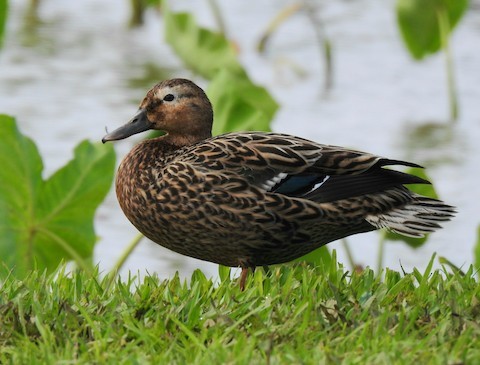
Hawaiian Duck. (Hanalei National Wildlife Refuge, Kauai, Hawaii; January 8, 2020.) © Joel Gilb
Endangered but still common on Kauai, rare and local on Oahu and the Big Island, and extirpated from Ni’ihau, Molokai, and Maui. Reliable sites on Kauai include Hanalei National Wildlife Refuge, Kawai’ele Waterbird Sanctuary, Kauai Lagoons, golf courses around Poipu, and Hanapepe. On Oahu, James Campbell National Wildlife Refuge is probably the most consistent site. On the Big Island, it breeds along streams on the eastern slope of the Kohala Range, including the Pololu and Waipio valleys, and can sometimes be found at ponds north and east of Waimea.
A mottled-brown duck in which both sexes resemble a female or eclipse-plumaged Mallard, with a speculum that varies from green to various shades of blue to purple. Immature males often show some green on the head, which can be interpreted as evidence of genetic dilution through hybridization with Mallards—but is also a natural trait in young male Hawaiian Ducks.
Hydrobatidae: Northern Storm-Petrels
Hawaii’s least-known endemic seabird is a storm-petrel that is either a species or an isolated population of a widespread species.
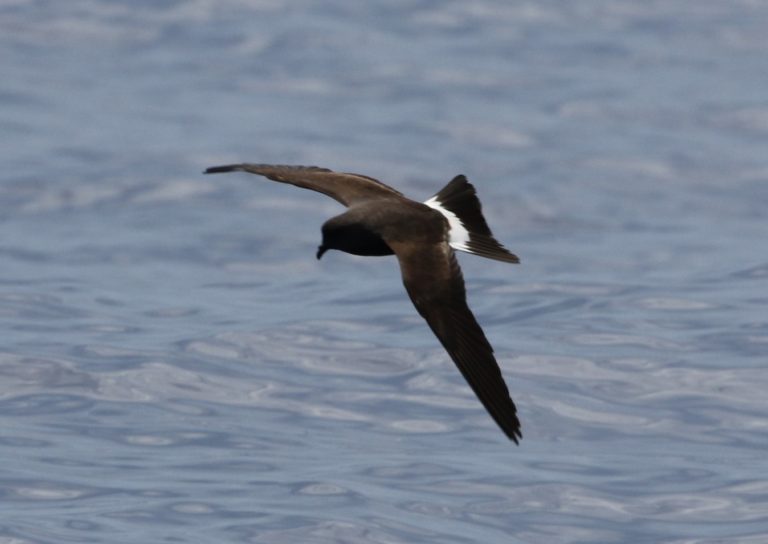
“Hawaiian Storm-Petrel,” T. c. cryptoleucura. (Offshore from Kailua-Kona, Big Island, Hawaii; July 23, 2016.) © Annie B. Douglas / Cascadia Research Collective
The Hawaiian endemic form of Band-rumped Storm-Petrel is rare and little-known overall, but locally common in the breeding season, between April and November. Most known nesting areas are on Kauai: mainly along the Na Pali Coast, but also in Waimea Canyon and elsewhere in the interior mountains. It is also known to nest on the Big Island at upper elevations of Mauna Kea and Mauna Loa, and suspected on Maui (in Haleakala Crater) and Lehua (north of Ni’ihau). Most sightings are on boat trips from Kauai, especially in Kaulakahi Channel, and the Big Island off of Kailua-Kona. It can sometimes be seen from shore, especially at Keahole Point on the Big Island and Makahuena Point on Kauai.
A mid-sized, dark-brown storm-petrel with an even white band across the rump and shallowly notched tail. Flight is steady and stable, often incorporating long glides on flat wings, at times more like a shearwater than other storm-petrels.
Procellariidae: Petrels and Shearwaters
Two endangered, endemic tubenoses—a petrel and a shearwater—nest in the mountains of the main Hawaiian islands.
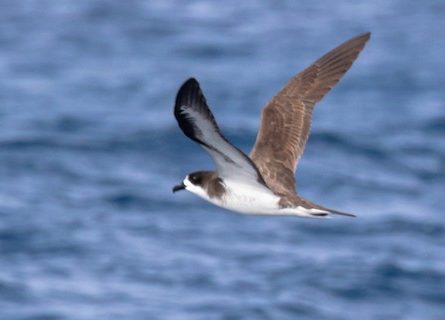
Hawaiian Petrel. (Offshore from Newport, Oregon; August 24, 2019.) © Ken Chamberlain
Endemic to the main Hawaiian Islands, where it breeds from February or March to October on Kauai, Lanai, Maui, the Big Island, and probably also on Molokai. Most nesting areas are in mountains, but the habitat varies from bare lava fields to cloud forest. The most accessible site is the rim of Haleakala Crater in Haleakala National Park, where breeding birds can be heard at night (and sometimes seen arriving around dusk) mostly from March to mid-August. The same is true at Lana’ihale on Lanai. It is reasonably likely on any Hawaiian pelagic trip throughout the breeding season, and there are a few prominent seawatches where it can sometimes be seen, especially Hanapepe, Makahuena Point, and Ninini Point on Kauai, and Keahole Point and Keokea Beach Park on the Big Island
A medium-large, long-tailed gadfly petrel with a prominent white forehead, otherwise all-dark upperparts, white underparts, and flashy black-and-white underwings. Calls heard at colonies include deep growls and sharp yelps.
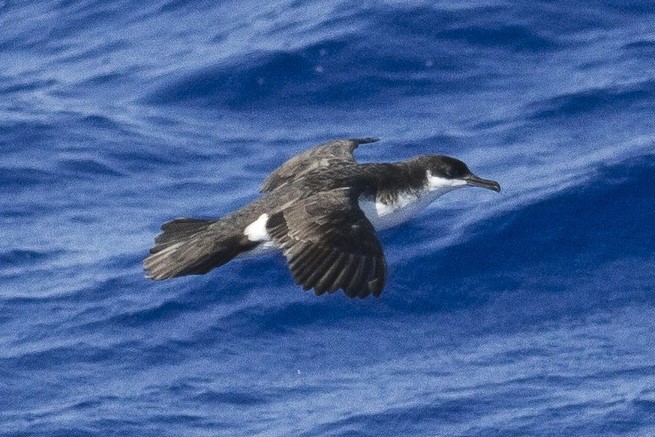
Newell’s Shearwater. (Kaulakahi Channel, Hawaii; April 3, 2016.) © Jacob Drucker
Endangered and declining, but still breeds in numbers on Kauai, where it is known for the fledglings’ attraction to outdoor lighting during September and October, which exposes them to predation and other lethal encounters. Also breeds on Lehua (north of Ni’ihau), Maui, and the Big Island, and possibly Molokai, Oahu, and Lanai. It can be seen around Kauai during the breeding season, from late March to October, offshore and from strategic coastal locations such as Makahuena Point, Ninini Point, Hanapepe, and Kilauea Point (where a few pairs have nested since the 2000s). Elsewhere in the main islands it can sometimes be seen during the breeding season from Keokea Beach Park on the Big Island and on pelagic trips out of Kailua-Kona.
A medium-small shearwater with crisply contrasting black upperparts and white underparts. Usually shows white “saddlebags” on the sides of the rump and a white gill-like indentation behind its black cheek.
Accipitridae: Hawks, Eagles, Kites, and Old World Vultures
Hawaii has a single endemic hawk, a distinctive insular species that apparently derives from the highly migratory Swainson’s Hawk of North America or a recent common ancestor.
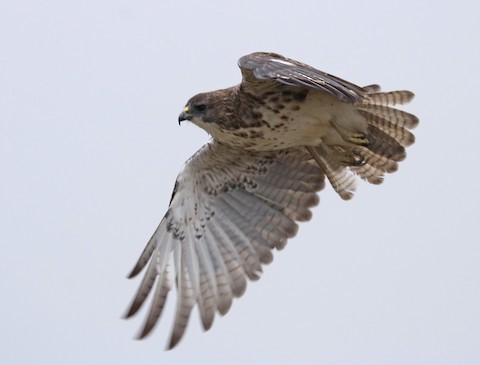
Hawaiian Hawk, pale morph. (Keanakolu Road, Big Island, Hawaii; August 30, 2017.) © Alan Schmierer
Endemic to the Big Island, where it occurs islandwide in or over all habitat-types, at all elevations, and remains fairly common. More numerous in forests and partly wooded areas than in open grassland and sugarcane fields. Sites where it can often be found include Saddle Road (especially the Pu’u O’o Trail and Powerline Road), Hakalau Forest National Wildlife Refuge, the central part of Hawaii Volcanoes National Park, the Pololu and Waipio Valleys, and in Kona at Kaloko Mauka and Kealakehua Bay.
An unusually short, stout, broad-winged Buteo with highly variable plumage. Often said to have a pale and a dark morph, but this dramatically understates the variability of its plumages. In all cases, the uppersides of the wings and tail are mostly dark-brown, but the rest of the plumage varies from whitish or pale-buffy to black. Typical call is a shrill “eee-oh,” the basis of its local name: the Io.
Rallidae: Rails, Gallinules, and Coots
Two or three species of flightless rails persisted in Hawaii into the modern era but are now extinct. Hawaii’s surviving endemic rallids are a gallinule and a coot. Both were traditionally considered subspecies of continental species, but the coot is now recognized as a separate species.
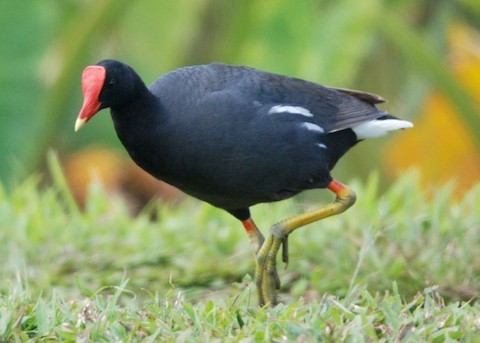
“Hawaiian Gallinule,” G. g. sandvicensis. (Hanalei National Wildlife Refuge, Kauai, Hawaii; April 15, 2016.) © Dave DeReamus
The Hawaiian endemic form of Common Gallinule has been extirpated from Ni’ihau, Molokai, Maui, and the Big Island, but remains locally common on Oahu and Kauai, where it occurs in freshwater marshes and ponds with emergent vegetation. Sites where it can often be found include: on Oahu, Hamakua Marsh, James Campbell and Pearl Harbor National Wildlife Refuges, and Waimea Valley Audubon Center; and on Kauai, Hanalei National Wildlife Refuge, Kawai’ele Waterbird Sanctuary, and coastal resorts, gardens, and golf courses, such as Kauai Lagoons in Lihue.
Very similar to the widespread continental forms, but tends to be blacker and have a larger red frontal shield. “Hawaiian” most resembles the “Altiplano Gallinule” of the central Andes.
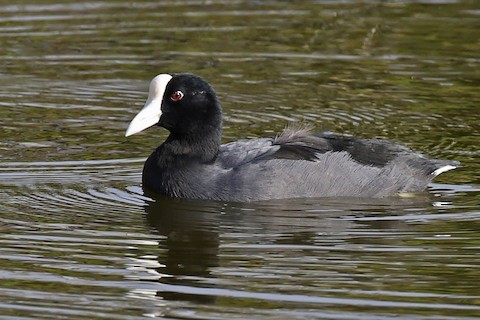
Hawaiian Coot. (Kealia Pond National Wildlife Refuge, Maui, Hawaii; December 5, 2016.) © Laura Keene
Endemic to Hawaii and resident on all the main islands, breeding in ponds with emergent vegetation. Not numerous but locally common and conspicuous in sheltered waters of all the main islands, especially Oahu and Kauai. Sites where it can often be found include: on Oahu, the Kawainui area and James Campbell and Pearl Harbor National Wildlife Refuges; on Kauai, Hanalei National Wildlife Refuge, Kauai Lagoons, and Kawai’ele Waterbird Sanctuary; on Maui, Kanaha and Kealia Ponds; and on the Big Island, Aimakapa Pond, Kealakehe, Pu’u Anahulu, and Wailoa River State Park.
A typical coot, but with an exaggerated, bulbous frontal shield that can be either white or maroon. It was long considered conspecific with the American Coot, which probably wanders to Hawaii from time to time—although any such occurrences would be difficult to notice because young Hawaiians can be nearly identical before their frontal shields are fully grown.
Hawaii’s sole endemic shorebird is a stilt that is generally regarded as a distinctive subspecies of a widespread continental species.
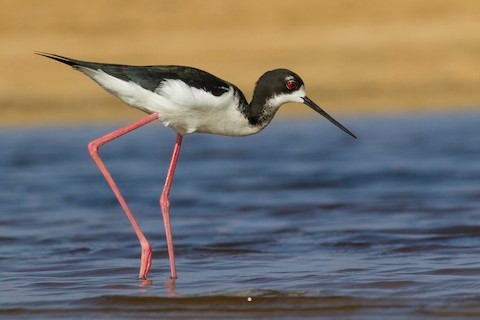
“Hawaiian Stilt,” H. m. knudseni. (Kekaha Beach Park, Kauai, Hawaii; April 5, 2016.) © Jacob Drucker
The Hawaiian endemic form of Black-necked Stilt is not numerous but it has increased and is locally common on all the main islands in fresh and saltwater marshes, ponds, and lagoons. Consistent sites include: on Oahu, Hamakua Marsh, James Campbell and Pearl Harbor National Wildlife Refuges; on Kauai, Hanalei National Wildlife Refuge, Kawai’ele Waterbird Sanctuary, and Kauai Lagoons; on Maui, Kanaha and Kealia Ponds; and on the Big Island, Aimakapa Pond, Kealakehe, and Pu’u Anahulu.
Very similar to the widespread continental Black-necked Stilt, but with a black tail band and more extensive black on the face and neck. These features vary but seem to be consistent enough to distinguish most, if not all, “Hawaiian Stilts” from continental Black-necked.
Laridae: Gulls, Terns, and Skimmers
The rough lava cliffs along the coasts of Hawaii’s main islands support an endemic noddy. It has traditionally been classified as a localized subspecies of the pantropical Black Noddy, but the differences are noticeable enough that eventual recognition as a separate species seems likely.
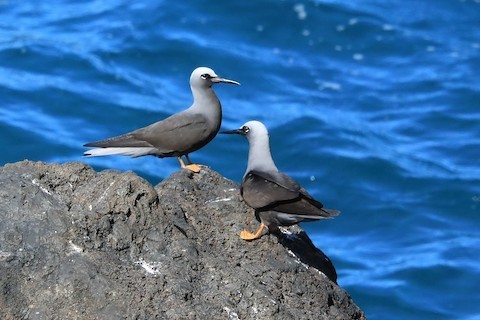
“Hawaiian Noddy,” A. m. melanogenys. (Wai’anapanapa State Park, Maui, Hawaii; March 26, 2019.) © Linda Kavanaugh
The Hawaiian endemic form of Black Noddy (perhaps more likely a separate Hawaiian species) is locally common from Ni’ihau to the Big Island, where it breeds year-round in small colonies on rocky cliffs and feeds mainly in nearby waters. Consistent sites include: on Kauai, Ha’ena State Park and the Na Pali Coast; on Oahu, Kawainui Regional Park, Makapu’u Point, and Ka’ena Point; on Maui, Wai’anapanapa State Park, Ke’anae, and the Oheo Gulch area of Haleakala National Park; and on the Big Island, Niuli’i, Keahole Point, South Point, and the Chain of Craters Road in Hawaii Volcanoes National Park.
Similar to other members of the Black Noddy complex, but adults have unique orange feet and extensively pale gray head and tail. Immatures are difficult to distinguish from the “Pacific Black Noddy”, which breeds throughout the Northwest Chain and occurs at least occasionally in the main islands.
Hawaii’s resident subspecies of Short-eared Owl is peculiar in being non-migratory, but otherwise lacks any consistent difference from the migratory continental stock that seeded it.
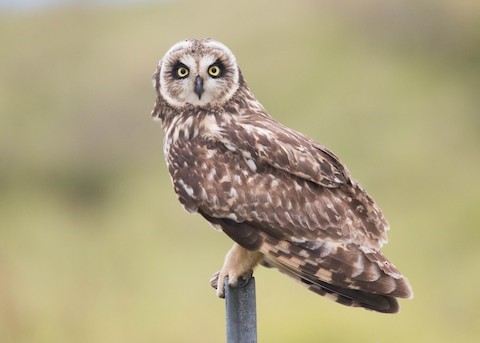
“Hawaiian Short-eared Owl,” A. f. sandwichensis. (Waiki’i Ranch, Big Island, Hawaii; May 26, 2017.) © Rudy Nuissl
The Hawaiian endemic form of Short-eared Owl, known as the Pueo, is resident on all eight of the major islands from Ni’ihau to the Big Island, where it occurs in all open habitats with sufficient ground cover for roosting. It is rare on Oahu, but locally common on the other islands. Consistent sites include: on Kauai, Waimea Canyon and the Kaumualii Highway; on Maui, Haleakala National Park and the Haleakala Highway; and on the Big Island, Waiki’i Ranch and Saddle Road.
This form seems to be indistinguishable from the widespread “Northern Short-eared Owl,” but somewhat less variable in coloration and pattern.
Hawaii is home to three closely related monarchs, the elepaios of Kauai, Oahu, and the Big Island. These are the northeasternmost representatives of this family, which is remarkably diverse and widespread across the tropical Pacific. Hawaii’s trio were traditionally regarded as a single species, despite pronounced differences in appearance and voice.
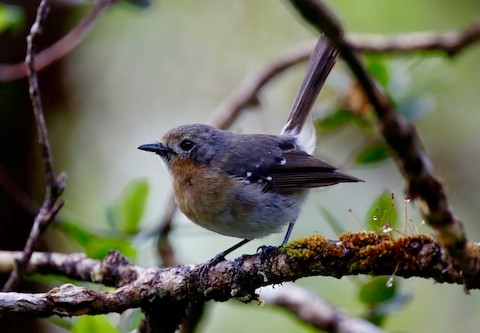
Kauai Elepaio. (Pihea Trail, Kauai, Hawaii; July 12, 2018.) © Timo Mitzen
Endemic to Kauai, where it occurs in forests nearly throughout, but mostly above 500 m elevation. Common in Koke’e State Park and above, where it can be found along most of the trails. It can also be found lower down in Waimea Canyon, and less reliably in the northern and eastern lowlands.
A perky little flycatcher with a long tail that it habitually cocks. Adult plumage is mostly gray above and whitish below, with a variable orange flush on the throat and chest, and prominent white rump and wingbars. The distinctive immature plumage appears mostly rusty-orange.
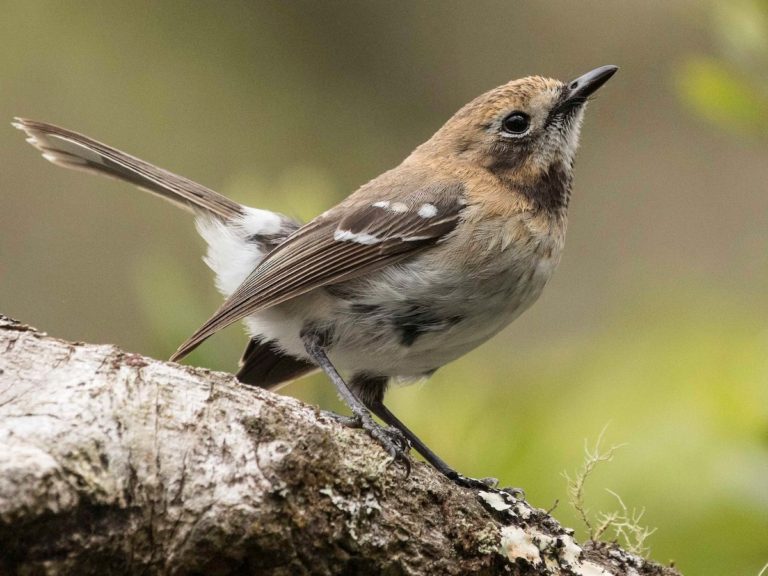
Oahu Elepaio. (Palikea, Oahu, Hawaii; April 16, 2019.) © Eric VanderWerf
Endemic to Oahu, where it occurs in foothill and montane rain forests of the Wai’anae and the central and southern Ko’olau Range. Formerly occurred throughout Oahu, but increasingly confined to a few areas in in the western and southeastern hills. It can be found consistently near Honolulu at Aiea Ridge, Wiliwilinui Ridge, Wailupe Valley, and Kuli’ou’ou Valley, and along Palehua Road in the Nanakuli Forest Reserve.
A perky little flycatcher with a long tail that it habitually cocks. Adult plumage is mostly brown above and whitish below, with a brownish chest, black bib, and prominent white rump and wingbars. The distinctive immature plumage appears mostly rusty-orange.
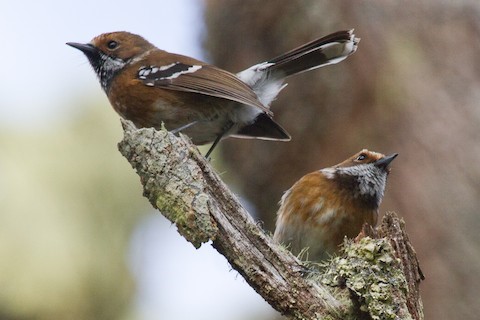
Hawaii Elepaio. (Pua Akala Tract, Hakalau Forest National Wildlife Refuge, Big Island, Hawaii; March 13, 2014.) © Eric VanderWerf
Endemic to the Big Island, where it occurs in native forests down to around 300 m elevation, nearly island-wide in suitable habitat, but more numerous on the eastern side. Sites where it can usually be found include Hawaii Volcanoes National Park, the Pu’u O’o Trail along Saddle Road, Pu’u La’au, and Hakalau Forest National Wildlife Refuge. Near Kailua-Kona the most likely site is Kaloko Mauka, but it has declined to the point that it is no longer reliably found there.
A perky little flycatcher with a long tail that it habitually cocks. Typical adult plumage is medium-brown above and rusty-brown below, with bold black-and-white markings on the throat, a white rump and undertail coverts, and two or three white wingbars. The localized north-central population, bryani, on the western slopes Mauna Kea, has a predominantly frosty morph.
Corvidae: Crows, Jays, and Magpies
Fossils indicate that prehistoric Hawaii supported multiple species of crow, but just one survived into modern times.
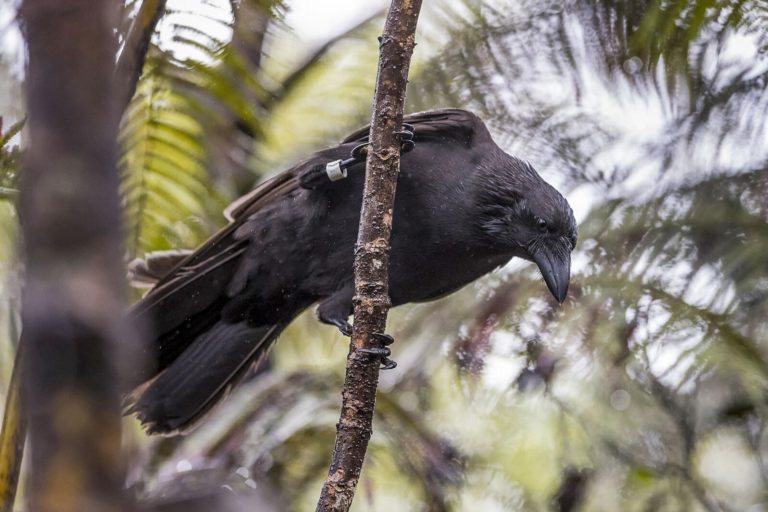
Hawaiian Crow. © San Diego Zoo Global
Endemic to the Big Island, where it last bred in the wild in 1992, and was extirpated in 2002. Since the 1990s, most of the global population has existed in captive-breeding facilities. A reintroduction effort began in 2016 but ended in 2020. Although the species no longer appears doomed, the re-establishment of a resilient wild population remains a distant goal.
A medium-large raven-like crow with a proportionately large, smooth bill and puffy plumage. All-black except for the flight feathers, which are brownish. Varied vocalizations include “a weird-sounding kee-o-reek, a quiet kwahk, and . . . a loud but musical kraa-a-a-ik, upslurred and somewhat modulated” (Pratt et al. 1987).
Three of Hawaii’s five native thrushes have gone extinct in modern times, probably all due to avian malaria or other insect-borne diseases. The two surviving species inhabit highlands of the Big Island and Kauai.
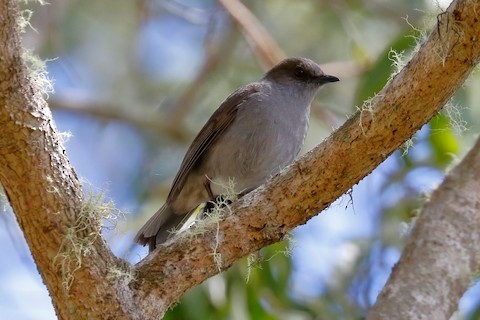
Oma’o. (Pu’u O’o Trail, Kipuka Ainahou, Big Island, Hawaii; March 28, 2018.) © Sharif Uddin
Endemic to the Big Island, where it occurs in native forests and scrub between about 700 and 3,000 m elevation. Remains locally common across the eastern and southern highlands of the Big Island. Sites where it can usually be found include the kipukas along Saddle Road (especially on the Pu’u O’o Trail), Hawaii Volcanoes National Park, and Hakalau Forest National Wildlife Refuge. Near Kailua-Kona the most likely site is Kaloko Mauka, but it has declined to the point that it is no longer reliably found there.
A plump, short-tailed Myadestes solitaire with brown upperparts, a darker mask or eyestripe, and medium-gray underparts. Traditionally considered conspecific with the Kama’o (M. myadestinus), Amaui (M. woahensis), and Oloma’o (M. lanaiensis), collectively known as the Hawaiian Thrush (M. obscurus), but recognized as separate species since 1982. The other three are thought to be extinct.
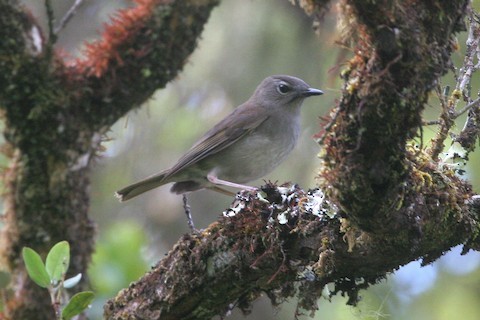
Puaiohi. (Alakai Wilderness Preserve, Kauai, Hawaii.) © Eric VanderWerf
Endemic to Kauai, where it is critically endangered but increasing. Essentially confined to upper elevation ohia forests of the Alakai Plateau, it spends most of its time in ravines with dense undergrowth. It has been rare since originally described in the 1890s, but it has benefited from conservation efforts. Visitors to Koke’e State Park and the Alakai Wilderness have only a slim hope of finding one, perhaps most likely in valleys of the Kawaikoi Stream drainage along the Pihea and Alakai Swamp Trails.
A plump, short-tailed Myadestes solitaire with brown upperparts, medium-gray underparts, a thin dark whisker mark, an incomplete, pale-gray eyering, and pale-pink legs. Immatures are heavily spotted on the underparts, head, and wings. Song is a musical, resonant, four-note phrase.
Hawaii lost one of its two reed-warblers, the “Laysan Millerbird,” which is usually classified as a subspecies of Millerbird (sibling to the still-surviving “Nihoa Millerbird”). Geographical constraints suggest that their populations were never unified, and the unanswered question is whether they would still be regarded as conspecific with their most recent common ancestor.
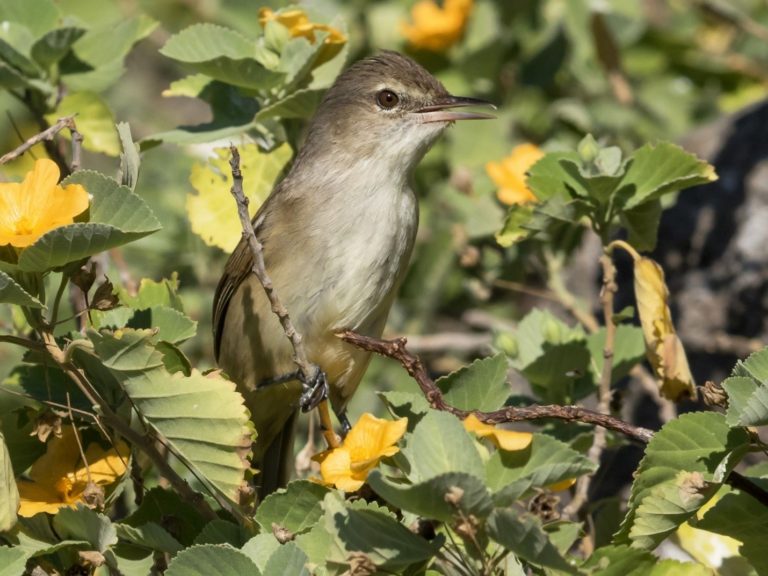
Millerbird. (Nihoa, Hawaii; August 22, 2016.) © Robby Kohley
Endemic to Laysan and Nihoa Islands in the Northwest Chain. The Nihoa population naturally fluctuates between about 200 and 800. The Laysan endemic subspecies (possibly a separate species), “Laysan Millerbird,” A. f. familiaris, was extirpated between 1915 and 1923, when introduced European Hares consumed most of the island’s vegetation. In 2011-12, a total of 50 “Nihoa Millerbirds,” A. f. kingi, were translocated to Laysan and by 2014 the new Laysan population had increased to an estimated 164.
A typically-plumed, drab Acrocephalus reed-warbler with short wings and a somewhat longer-than-average bill and tail. Often shows a strong yellowish wash on the sides and/or lower belly.